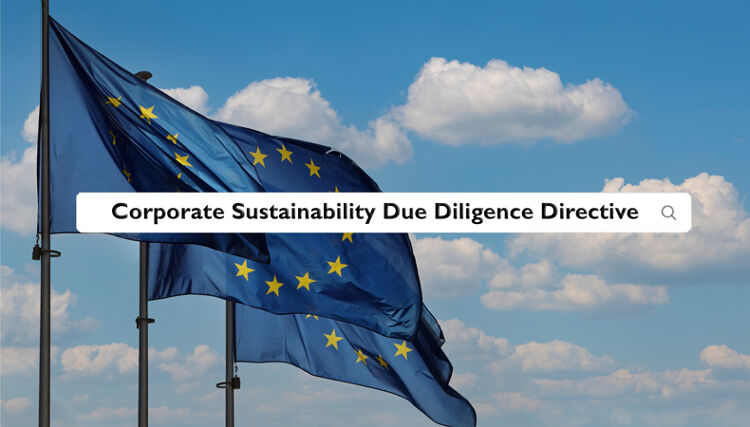Regulation guidance: CS3D

How does the Corporate Sustainability Due Diligence Directive (CS3D) affect printers, and what do they need to do to ensure compliance? Sustainability consultant Rachel England outlines everything you need to know.
The Corporate Sustainability Due Diligence Directive (known as CS3D or CSDDD) is part of the European Green Deal, the overarching aim of which is to make the EU’s climate, energy, transport and taxation policies climate neutral by 2050.
CS3D became law on 25 July 2024 and is designed to foster responsible and sustainable behaviour within companies’ operations and across their value chains. It’s a groundbreaking regulation in two key respects. Firstly, it introduces mandatory human rights and environmental due diligence for companies, moving away from the generally voluntary nature of such due diligence. Secondly, it sets out an obligation for large companies to adopt and put into effect a transition plan for climate change mitigation aligned with the 2050 climate neutrality objective of the 2015 Paris Agreement.
For citizens, CS3D promises better protection of human rights, including labour rights, a healthier environment, and more transparency around goods and services, leading to more informed choices and increased trust in businesses. For companies, compliance with the directive offers better risk management and resilience, a harmonised legal framework that creates legal certainty, and further benefits such as increased competitiveness, customer and investor appeal, and better access to finance.
CS3D goes hand-in-hand with the Corporate Sustainability Reporting Directive (CSRD), but there are key differences. CS3D is about identifying areas for action and making changes, whereas CSRD is about reporting on changes made. However, a business cannot comply with CSRD without conducting due diligence, so there is an overlap between the regulations.
Who is affected by CS3D?
CS3D applies to:
-
Large EU limited liability companies and partnerships with more than 1,000 employees and a net worldwide turnover of more than €450 million.
-
Large non-EU companies with a net EU turnover of € 450 million.
Micro companies and SMEs are not directly covered by the proposed rules. However, they could be indirectly affected as business partners in value chains, so it’s important that they are aware of the requirements of CS3D.
What are the obligations of CS3D?
The core elements of this duty are identifying and addressing potential and actual adverse human rights and environmental impacts in the company’s own operations, their subsidiaries and, where related to their value chains, those of their business partners. Compliance activities will include:
-
Integrating due diligence into policies and risk management systems
-
Identifying and assessing actual or potential adverse human rights and environmental impacts
-
Preventing and mitigating potential impacts
-
Providing remediation for adverse impacts
-
Engaging with stakeholders
-
Establishing and maintaining notification processes and complaints procedures.
How does the Omnibus proposal affect CS3D requirements?
Under the European Green Deal, businesses need to comply with a raft of overlapping sustainability directives, including CSRD, CS3D and the EU Taxonomy Regulation. In response to concerns over this administrative burden, the European Commission has adopted the first draft of its ‘Simplification Omnibus Package’, designed to make compliance with these directives more manageable.
For CS3D, this now means that application of the directive has been pushed back by one year, assessment frequency has been extended from every year to every five years, penalties for non-compliance are no longer linked to company turnover, and due diligence will only focus on direct business partners (Tier 1 suppliers).
Under the Omnibus proposal, Member States will have to transpose the directive into national law and communicate the relevant texts to the Commission by 26 July 2027. One year later, the rules will start to apply to the first group of companies, following a staggered approach, with full application of the directive on 26 July 2029.
Companies could face a range of consequences for non-compliance, including regulatory investigations and fines. In cases of breach of due diligence obligations, companies could also face civil liability claims, with trade unions and NGOs able to bring claims on behalf of affected parties.
How does CS3D affect the print industry?
Given the size and scale of businesses in scope of CS3D, most printers will not be directly affected by the directive. However, as Teresa Borba, Director General of Apigraf, says, that does not mean they won’t feel the impacts of its requirements.
“Most of our industry will essentially feel an indirect impact due to bigger clients wanting information and data that an SME might – better said, will – find difficult to supply,” she says.
“The industry is currently under a heavy legal burden, with high management, administrative and logistics costs, due to several legislations that are becoming a part of companies’ life all at once. Due to the size of most companies, it can be difficult to understand what is required, from whom and how, and how to proceed to make the necessary changes.”
However, the Omnibus package brings measures that will help to ease the load. Under the draft, due diligence measures will be limited to a company’s own activities and the activities of its direct business partners and Tier 1 suppliers – and not all business partners, including indirect business partners, as outlined in the original CS3D guidance. This means that fewer print businesses are likely to be caught in the reporting requirements of bigger companies.
But the Omnibus package does include a clause that states that evaluations of indirect business partners will be conducted only under specific circumstances, particularly when credible information indicates that adverse impacts may have occurred or could potentially occur within the operations of an indirect business partner’. Given the potentially impact-heavy nature of the print industry, printers therefore need to be ready to respond with data if requested by their partners.
“In summary, while the CS3D primarily targets large EU companies and non-EU companies with significant EU activity, printers are still likely to be indirectly affected through their role in the supply chains of these larger companies,” says Borba. “They may need to provide data, cooperate with due diligence efforts, and be aware of the potential for reputational risks and penalties if their clients fail to comply with the CS3D. This will involve stepping back and rethinking not only procedures and information gathering systems but also how to engage up and downstream in order to get information from their own suppliers and clients.”
Despite these challenges, however, Borba remains optimistic. “Our industry, a hallmark of innovation, has persevered over time and is now so deeply integrated into everyday life that it often goes unnoticed. While we face challenging moments, we have full confidence in the industry's future and its ability to adapt.”
Become a FESPA member to continue reading
To read more and access exclusive content on the Club FESPA portal, please contact your Local Association. If you are not a current member, please enquire here. If there is no FESPA Association in your country, you can join FESPA Direct. Once you become a FESPA member, you can gain access to the Club FESPA Portal.
Recent news

Sustainability, seaweed and storytelling
Joanne O’Rourke, winner of the Epson Design Award, discusses the interface between storytelling, nature, craft and innovation in her business, and how the Personalisation Experience 2025 was a career-defining moment.

What’s new in stamping foils? Bringing extra sparkle to print products
Stamping foil can help your products to really stand out – and you can probably do it with the equipment you already have. We speak to Matt Hornby of foil specialists Foilco.

The intelligence behind the ink: how AI is changing printing forever
Keypoint Intelligence, the global market data leader for the digital imaging industry, showed the growing application of artificial intelligence to all facets of printing at the SmartHub Conference at the Personalisation Experience 2025, co-located at the FESPA Global Print Expo earlier this month.

How to choose the best courier for safe shipping
As a printer, making sure your work is high-quality is only half the job – delivering to the customer on time and intact is just as important. Reliable courier services are vital for your business reputation, so here’s what to look for in a delivery partner, and why automation may be one way you can boost your business.